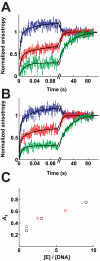Coupling between ATP binding and DNA cleavage by DNA topoisomerase II: A unifying kinetic and structural mechanism
- PMID: 18403371
- PMCID: PMC2427340
- DOI: 10.1074/jbc.M710014200
Coupling between ATP binding and DNA cleavage by DNA topoisomerase II: A unifying kinetic and structural mechanism
Abstract
DNA topoisomerase II is a molecular machine that couples ATP hydrolysis to the transport of one DNA segment through a transient break in another segment. To learn about the energetic connectivity that underlies this coupling, we investigated how the ATPase domains exert control over DNA cleavage. We dissected the DNA cleavage reaction by measuring rate and equilibrium constants for the individual reaction steps utilizing defined DNA duplexes in the presence and absence of the nonhydrolyzable ATP analog 5'-adenylyl-beta,gamma-imidodiphosphate (AMPPNP). Our results revealed the existence of two enzyme conformations whose relative abundance is sensitive to the presence of nucleotides. The predominant species in the absence of nucleotides binds DNA at a diffusion limited rate but cannot efficiently cleave DNA. In the presence of AMPPNP, most of the enzyme is converted to a state in which DNA binding and release is extremely slow but which allows DNA cleavage. A minimal kinetic and thermodynamic framework is established that accounts for the cooperativity of cleavage of the two DNA strands in the presence and absence of bound AMPPNP and includes conformational steps revealed in the kinetic studies. The model unifies available kinetic, thermodynamic, and structural data to provide a description for the reaction in terms of the order and rate of individual reaction steps and the physical nature of the species on the reaction path. Furthermore, this reaction framework provides a foundation for a future in-depth analysis of energy transduction by topoisomerase II, for guiding and interpreting future structural studies, and for analyzing the mechanism of drugs that convert topoisomerase into a cellular poison.
Figures










Similar articles
-
Hindering the strand passage reaction of human topoisomerase IIalpha without disturbing DNA cleavage, ATP hydrolysis, or the operation of the N-terminal clamp.J Biol Chem. 2004 Jul 2;279(27):28093-9. doi: 10.1074/jbc.M402120200. Epub 2004 Apr 28. J Biol Chem. 2004. PMID: 15123700
-
A human topoisomerase II alpha heterodimer with only one ATP binding site can go through successive catalytic cycles.J Biol Chem. 2003 Feb 21;278(8):5768-74. doi: 10.1074/jbc.M210332200. Epub 2002 Dec 11. J Biol Chem. 2003. PMID: 12480934
-
Pre-steady-state analysis of ATP hydrolysis by Saccharomyces cerevisiae DNA topoisomerase II. 2. Kinetic mechanism for the sequential hydrolysis of two ATP.Biochemistry. 1998 May 19;37(20):7299-312. doi: 10.1021/bi9729108. Biochemistry. 1998. PMID: 9585544
-
Coupling ATP hydrolysis to DNA strand passage in type IIA DNA topoisomerases.Biochem Soc Trans. 2005 Dec;33(Pt 6):1460-4. doi: 10.1042/BST0331460. Biochem Soc Trans. 2005. PMID: 16246146 Review.
-
Analysis of the eukaryotic topoisomerase II DNA gate: a single-molecule FRET and structural perspective.Nucleic Acids Res. 2009 Feb;37(3):712-20. doi: 10.1093/nar/gkn1059. Epub 2009 Jan 20. Nucleic Acids Res. 2009. PMID: 19155278 Free PMC article. Review.
Cited by
-
Local sensing of global DNA topology: from crossover geometry to type II topoisomerase processivity.Nucleic Acids Res. 2011 Nov 1;39(20):8665-76. doi: 10.1093/nar/gkr556. Epub 2011 Jul 15. Nucleic Acids Res. 2011. PMID: 21764774 Free PMC article.
-
The rate of opening and closing of the DNA gate for topoisomerase II.Theory Biosci. 2013 Mar;132(1):61-4. doi: 10.1007/s12064-012-0163-2. Epub 2012 Aug 14. Theory Biosci. 2013. PMID: 22890500
-
How to measure and evaluate binding affinities.Elife. 2020 Aug 6;9:e57264. doi: 10.7554/eLife.57264. Elife. 2020. PMID: 32758356 Free PMC article.
-
Structural basis of chiral wrap and T-segment capture by Escherichia coli DNA gyrase.Proc Natl Acad Sci U S A. 2024 Dec 3;121(49):e2407398121. doi: 10.1073/pnas.2407398121. Epub 2024 Nov 26. Proc Natl Acad Sci U S A. 2024. PMID: 39589884 Free PMC article.
-
Metal ion interactions in the DNA cleavage/ligation active site of human topoisomerase IIalpha.Biochemistry. 2009 Sep 29;48(38):8940-7. doi: 10.1021/bi900875c. Biochemistry. 2009. PMID: 19697956 Free PMC article.
References
-
- Vale, R. D. (2003) Cell 112 467-480 - PubMed
-
- Alberts, B. (1998) Cell 92 291-294 - PubMed
-
- Bustamante, C., Keller, D., and Oster, G. (2001) Acc. Chem. Res. 34 412-420 - PubMed
-
- Wang, J. C. (1996) Annu. Rev. Biochem. 65 635-692 - PubMed
-
- Brown, P. O., and Cozzarelli, N. R. (1979) Science 206 1081-1083 - PubMed
Publication types
MeSH terms
Substances
Grants and funding
LinkOut - more resources
Full Text Sources
Molecular Biology Databases

